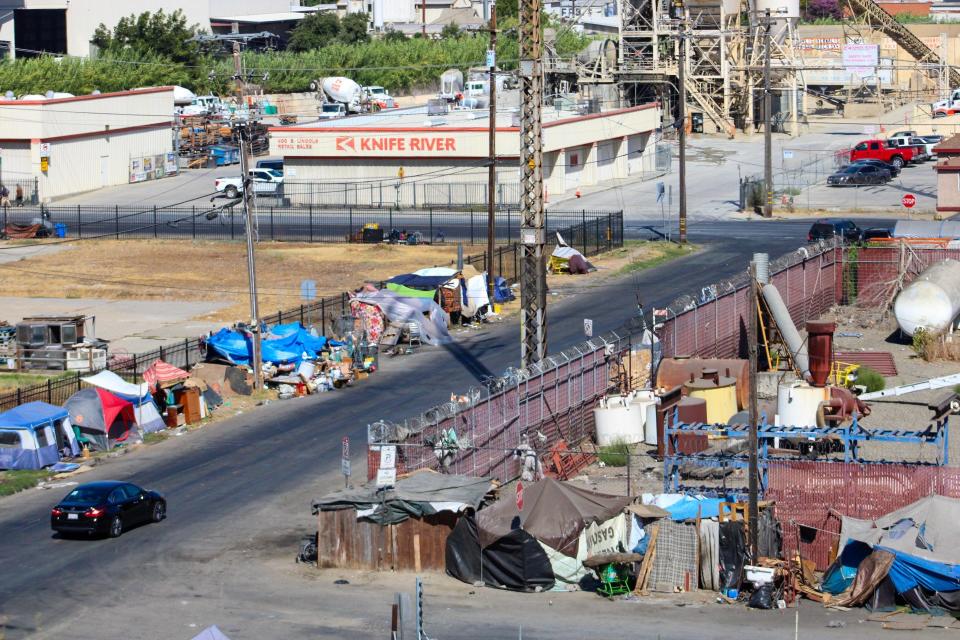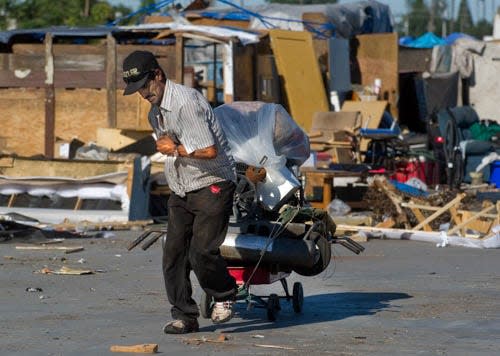$11 million won't clear the Crosstown Freeway homeless encampment. Here's why
Last month, California awarded San Joaquin County $11.2 million to move homeless residents out of one of Stockton's largest encampments.
Home to between 200 and 500 people, the "Interchange Complex" surrounds the Crosstown Freeway and Interstate 5 overpass. In recent years, it has been a magnet for "uncontrolled fires, violence, and crime," county documents state.
The $11 million grant sounds like a lot of money, but only 56 to 72 encampment residents will be moved into permanent housing using the money under the county's current plan.
That’s according to documents San Joaquin County officials sent to the state to obtain the funding — and to Stockton homeless advocates who will be putting the plan into action.
“This project is going to go a long way to help and get a lot of people out of homelessness,” said Fred Sheil, administrator of Stocktonians Taking Action to Neutralize Drugs (STAND).

“Is it going to get everyone out of the encampment? No.”
That may come as a disappointment — to those living in the Interchange Complex and to those housed Stocktonians who call officials daily demanding encampments be removed.
'How are we supposed to compete with a hedge fund?'
The reason is simple. “We do not have housing that’s affordable,” said Petra Linden, CEO of St. Mary's Dining Room.
Of the $11 million, about $9 million will go toward buying property converted into permanent housing, Sheil said.
In the current housing market, $9 million doesn’t go far. As of September, it could buy roughly 20 median-priced homes in San Joaquin County, according to Realtor.com data.
STAND will be in charge of buying and renovating the housing. And although it plans to buy multi-unit properties rather than individual homes, the market will likely still drive up the price tag.
"Wall Street investors and hedge funds buy this stuff from the lenders,” Sheil said.
“How are we supposed to compete with a hedge fund with $10 billion in capital, buying up everything they can find?"
Housing 'pipeline' — or bottleneck?
Rather than clearing the Interchange Complex once and for all, the $11 million plan is intended to create a “pipeline” from the encampment to permanent housing, Linden said.
Broadly speaking, there will be three steps.
First, three outreach workers — hired using roughly $780,000 of the $11 million, according to Linden — will spend time with encampment residents. They will help them get doctor’s appointments, medication, treatment for substance abuse, and other immediate needs, according to the CEO.
"Once we establish that trust and rapport, then we do a housing assessment," she said.
They answer several questions.
What kind of housing would be the best fit for them?
Can they live independently and be a tenant?
Do they need, for example, a caregiver?
Would board and care work?
Do they have a partner?"

Those most vulnerable in terms of physical disabilities, mental health conditions, or other circumstances will be first on the list for shelter, Linden said.
In the second step, some people will move into temporary shelters. In the documents, county officials said they plan to move 150 encampment residents into temporary shelter.
The county doesn't appear to have the resources to do that. On any given night, few — if any — of the county’s hundreds of shelter beds are free.
However, two new facilities currently being built are expected to add 180 and 326 beds, respectively. Interchange Complex residents will vie with the rest of the county's homeless population for the space.
The third step — at least in theory — is permanent housing. Between 56 and 72 people will live in homes bought with the money.
That represents 11% and 36% of the Interchange Complex's residents. STAND expects about half the people to seek permanent housing on their own after about six months, according to Sheil.
'The community is frustrated'
As long as housing remains mercilessly expensive — whether purchased by organizations like STAND or ordinary people — the envisioned pipeline out of unsheltered homelessness will remain more of a bottleneck.
“There are new homeless people getting created every day. Every month," Sheil said. "And we don’t even know how many."
The first goal is to end unsheltered homelessness, Linden said. "I think homelessness, in general, is a harder task."
“Our clients are frustrated," she said. "We are frustrated. The community is frustrated."
Record reporter Aaron Leathley covers public safety. She can be reached at aleathley@recordnet.com or on Twitter @LeathleyAaron. Support local news, subscribe to The Stockton Record at https://www.recordnet.com/subscribenow.
This article originally appeared on The Record: $11M won't clear the Crosstown Fwy. homeless encampment. Here's why

